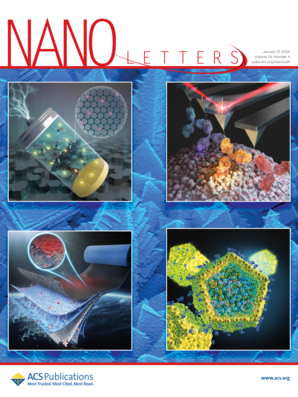基于纳米晶界面工程的光稳定钙钛矿太阳能电池降解途径裁剪
IF 9.6
1区 材料科学
Q1 CHEMISTRY, MULTIDISCIPLINARY
引用次数: 0
摘要
虽然有机-无机杂化钙钛矿(ABX3)具有巨大的光伏潜力,但由缺陷介导的离子迁移和光诱导降解引起的操作不稳定性仍然是一个关键瓶颈。在这里,我们采用Cs2PbI2Cl2纳米晶体(cpc - nc)和CsPbCl3纳米晶体(cpc - nc)来修饰钙钛矿吸光层的界面。除了传统的缺陷修复作用(Cs+/卤化物填充A/ x位点空缺),这种修饰可以从根本上改变钙钛矿薄膜在光照射下的降解途径。我们的研究表明,cpc - nc作为一种优良的改性剂,可以诱导更可控的Pb(OH)I的形成,并有效地抑制钙钛矿在长期光老化后分解成碘化铅。通过对太阳能电池进行cpc - nc改性,获得了24.28%的冠军功率转换效率。此外,未封装的器件在iso - l - 1i和iso - d -1条件下分别在600 h和4500 h后保持了90%以上的初始效率。这项工作建立了纳米晶体介导的界面控制作为钙钛矿光电子学的双缺陷/降解调节策略。本文章由计算机程序翻译,如有差异,请以英文原文为准。

Degradation Pathway Tailoring through Nanocrystal Interface Engineering for Photostable Perovskite Solar Cells
While organic–inorganic hybrid perovskites (ABX3) hold immense photovoltaic potential, operational instability originating from defect-mediated ion migration and light-induced degradation remains a critical bottleneck. Here, we adopt Cs2PbI2Cl2 nanocrystals (CPIC-NCs) and CsPbCl3 nanocrystals (CPC-NCs) to modify the interface of the perovskite light-absorbing layer. Beyond conventional defect-healing roles (Cs+/halide filling of the A/X-site vacancies), this modification can fundamentally alter the degradation pathways of perovskite films under light exposure. Our study reveals CPIC-NCs serve as a superior modifier by inducing a more controllable formation of Pb(OH)I and effectively suppressing the decomposition of perovskite into lead iodide after long-term light aging. Following the CPIC-NCs modification of the solar cells, a champion power conversion efficiency of 24.28% was achieved. Moreover, the unencapsulated devices retained over 90% of their initial efficiency after 600 h under ISOS-L-1I and 4500 h under ISOS-D-1 conditions. This work establishes nanocrystal-mediated interface control as a dual-defect/degradation regulatory strategy for perovskite optoelectronics.
求助全文
通过发布文献求助,成功后即可免费获取论文全文。
去求助
来源期刊

Nano Letters
工程技术-材料科学:综合
CiteScore
16.80
自引率
2.80%
发文量
1182
审稿时长
1.4 months
期刊介绍:
Nano Letters serves as a dynamic platform for promptly disseminating original results in fundamental, applied, and emerging research across all facets of nanoscience and nanotechnology. A pivotal criterion for inclusion within Nano Letters is the convergence of at least two different areas or disciplines, ensuring a rich interdisciplinary scope. The journal is dedicated to fostering exploration in diverse areas, including:
- Experimental and theoretical findings on physical, chemical, and biological phenomena at the nanoscale
- Synthesis, characterization, and processing of organic, inorganic, polymer, and hybrid nanomaterials through physical, chemical, and biological methodologies
- Modeling and simulation of synthetic, assembly, and interaction processes
- Realization of integrated nanostructures and nano-engineered devices exhibiting advanced performance
- Applications of nanoscale materials in living and environmental systems
Nano Letters is committed to advancing and showcasing groundbreaking research that intersects various domains, fostering innovation and collaboration in the ever-evolving field of nanoscience and nanotechnology.
 求助内容:
求助内容: 应助结果提醒方式:
应助结果提醒方式:


